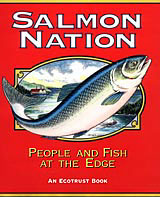Salmon NationEdited by Edward C. Wolf and Seth Zuckerman,Ecotrust, 1999, 80 pages
This essay is excerpted from the new book Salmon Nation: People and Fish at the Edge, published by the environmental group Ecotrust.
Thirty percent of the world’s salmon now come from hatcheries, but wild fish account for only another twenty to thirty percent. Almost all of those wild fish come from waters around Alaska and British Columbia, northern waters where runs are mostly intact. These are the waters from which we harvest volumes comparable to those native people caught for thousands of years, that is, in those places largely unmanaged. The biggest share of the world’s salmon consumption, however — now forty to fifty percent — comes from farmed fish, salmon raised and fed artificially in net pens their entire lives.
The rise of salmon farming worldwide helps explain a puzzling paradox in the economic picture. We understand that salmon runs are troubled, even endangered in some places. Scarcity ought to dictate a high price, yet salmon fishermen, especially in recent years, have faced catastrophically low prices. Chinook ... Read more
